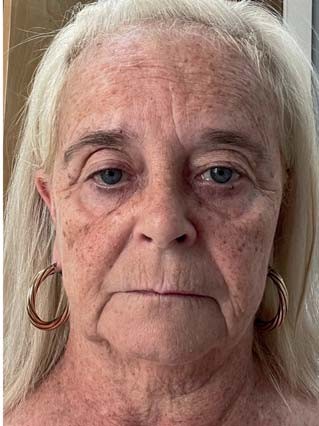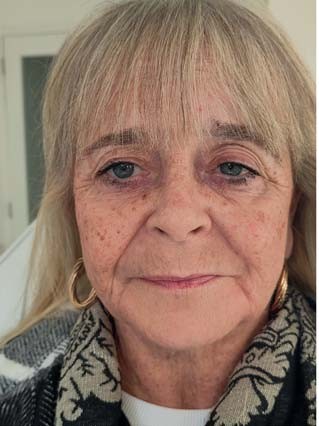POLYNUCLEOTIDES
Combining polynucleotides
Skin Appeal Clinic’s nurse prescriber Neil Pybis presents his solution to premature ageing using a holistic treatment approach
Botulinum toxin and hyaluronic acid dermal fillers have become the ‘bread and butter’ of most medical aesthetic practitioners’ treatment strategies. They are a reliable method to address wrinkles and sagging, providing patients with a smoother, more youthful appearance.
What they can’t do, however, is address the signs of ageing on a cellular level. But this is where polynucleotides come in. Using purified DNA fractions encapsulated in an injectable gel, polynucleotides work by repairing damaged and aged fibroblasts so can get to work to enhance the signs of ageing. They can be used to treat fine lines and wrinkles, hyperpigmentation, rosacea, scarring, and poor skin tone and texture.1
I’ve now been using polynucleotides as a standalone treatment and in combination with other common procedures for more than a year. The benefits have been significant – I’m able to boost results, increase patient satisfaction and stand out from the crowd with another effective treatment option.
Here, I share a patient’s journey to a more youthful appearance using toxin, HA dermal fillers, peels and polynucleotides. Both she and I are delighted with the results, which have taken just four months to achieve.
PATIENT CONCERNS AND ASSESSMENT
Like many women of her age, my 56-year-old patient came to see me as she was disappointed in her appearance and wanted to start looking after herself. She had been smoking since she was 16 and drinking since 20 but gave these up two years ago and was honest that she had been a sun worshipper all her life.
From her perspective, my patient’s main concerns were the quality of her skin texture and laxity, the age spots, overall volume loss and appearance of her jawline.
Upon assessment at her consultation in September 2023, I noted that my patient’s skin was dehydrated, red and hyperpigmented with multiple age spots. She also had noticeable tear troughs and skin laxity in the mid and lower face, with deep nasolabial folds and marionette lines.
I recognised that a combination approach was going to be the best solution to my patient’s concerns, so built a plan that involved the use of dermal fillers to lift her face, botulinum toxin to reduce the appearance of wrinkles, and peels and polynucleotides to enhance her overall skin quality.
MULTI-MODAL TREATMENT PLAN
My patient’s treatment began on September 20 with polynucleotides. We agreed to start with the polynucleotides as they’ve been clinically proven to help prime the skin prior to filler, laser, radiofrequency and chemical peel treatment. Research has found that the best results can be achieved if used before the second treatment, while if used afterwards, polynucleotides can help skin look better for longer.2
I administered 50mg of Plenhyage, spread evenly around the periocular area using a needle and superficial injection technique, before changing to a cannula to inject the mid and lower face areas.
For my patient’s second appointment, two and a half weeks later on October 11, I switched to 40mg Plinest, injected under the eyes and to the lower face using the same approach as I did in the first appointment. Her third appointment took place on November 1, and again I focused on injecting under the eyes and in the lower face with the same technique.
While results from polynucleotides generally take three months to optimise, a noticeable difference was apparent within two weeks of the first treatment. We could see a reduction in her pigmentation concerns, as well as an improvement in skin laxity and general quality.
Two weeks later, on November 15, we proceeded with dermal filler treatment. I used 0.8ml of Teosyal RHA4 in a cannula to lift either side of her cheeks using a bolus and retrograde injection layer technique, under deep and superficial fat pads to give maximum projection and a beautifully natural enhancement.
On November 25, I then focused on addressing the barcode lines around her mouth, which had developed from years of smoking and contributed significantly to my patient’s premature ageing. I performed subcision to the area before using 1ml of Teosyal RHA 1 with a superficial cannula technique, which reduced the deeper lines, while smoothing crepeyness and restoring a more youthful perioral appearance.
In the same session, I administered 40 units of Azzalure botulinum toxin to my patient’s glabella and 20 units either side to her lateral canthal lines either side of her eyes.
On December 6, I addressed my patient’s jawline and marionette lines. 0.5ml of Teosyal Deep was administered to the lateral aspects of her jawline using a cannula deep to the bone, using retrograde injections. RHA4 was then placed superficially to the medial aspects of the jawline, with 0.7ml RHA3 either side, using a cannula and retrograde injection technique, with 0.2ml bolus to the oral commissures to aid support. This approach helped to lift the sagginess around my patient’s jawline, giving her more definition in her lower face, while helping to soften the perioral area.
To conclude my patient’s treatment plan, I performed two superficial skin peels with the Milk Peel by Dermaceutic. This peel includes glycolic, lactic and salicylic acids, which help to eliminate superficial pigmented lesions and boost collagen production to enhance the impact of the earlier polynucleotide treatment and improve the appearance of fine lines and wrinkles.
My patient experienced the general side effects associated with injectable treatment, which included slight redness and swelling immediately after the procedure. Of course, I informed her of these beforehand, so she knew what to expect. I also made her aware of potential complications such as infection or vascular occlusion following filler injection and provided her with emergency contact details should any signs of these present outside of clinic. Thankfully, none occurred.
OPTIMISED RESULTS
In just four months, I was able to significantly improve my patient’s ageing concerns and boost her confidence. As the before-and-after photographs show, her sagging cheeks have been lifted, deep lines and tear troughs have been reduced, while her skin looks brighter and less pigmented.
In my patient’s own words, she said, “This is the happiest I have been in years. I feel so much more confident in myself, and my husband and family are so happy for me –they can see the change and that has been so positive. I feel like a huge weight has been taken off my shoulders. I am that confident –who needs makeup?!”
My patient’s ongoing treatment plan will include topical skincare, including a mild cleanser, toner and vitamin C serum with a hyaluronic acid-based moisturiser. She will also undergo a monthly Milk Peel and review of her skin quality in six to nine months for additional polynucleotide treatment and review for dermal filler top up in nine months, or as required.
While the positive impact that dermal fillers and botulinum toxin have on reducing signs of ageing cannot be underestimated, it’s important to remember that they have a limited effect on overall skin quality.
Introducing polynucleotides to your treatment plans will address multiple skin concerns on a cellular level – optimising results to the benefit of you and your patients.

Before

After
REFERENCES
1. Cavallini M, Bartoletti E, Maioli L, Massirone A, Pia Palmieri I, Papagni M, Priori M, Trocchi G; As Members of The Polynucleotides HPT™ Priming Board, Collegio Italiano delle Società Scientifiche di Medicina Estetica (Italian College of the Aesthetic Medicine Scientific Societies) -SIME, AGORÀ, SIES. Consensus report on the use of PN-HPT™ (polynucleotides highly purified technology) in aesthetic medicine. J Cosmet Dermatol. 2021 Mar;20(3):922-928. doi: 10.1111/jocd.13679. Epub 2020 Sep 21. PMID: 32799391; PMCID: PMC7984045.
2. Araco A, Araco F. Preliminary Prospective and Randomized Study of Highly Purified Polynucleotide vs Placebo in Treatment of Moderate to Severe Acne Scars. Aesthet Surg J. 2021 Jun 14;41(7):NP866-NP874. doi: 10.1093/asj/sjab125. PMID: 33755110.